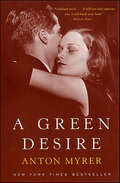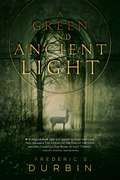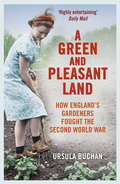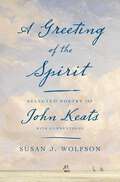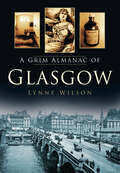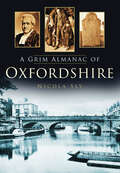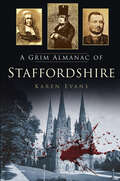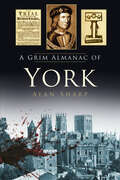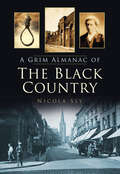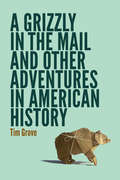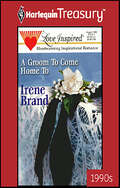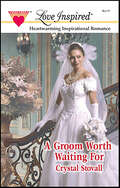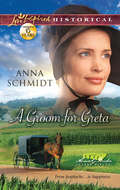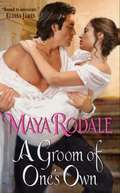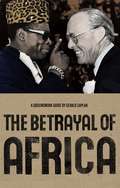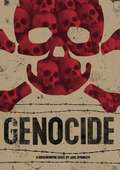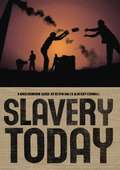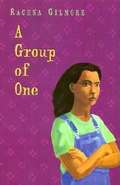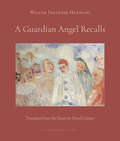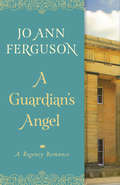- Table View
- List View
A Green Desire
by Anton MyrerTwo brothers, as different as night and day: one, charming and ruthless, buys his way into Harvard, Wall Street, and high society; the other brother remains by his mother's side and makes his way to the top without the influence of money or prestige.Raised in separate worlds, these brothers are bound by a bitter rivalry for riches and power, but mostly, for the exciting, wildly captivating woman they fight all their lives to possess, a woman whose passion for one destroys her love for the other.Their story consumes an American century, spanning decades of splendor, struggle, upheaval, and war. It's an absorbing saga of innocent dreams and green desire corrupted by gilded temptation.
A Green and Ancient Light
by Frederic S. DurbinA gorgeous fantasy in the spirit of Pan's Labyrinth and John Connolly's The Book of Lost Things.Set in a world similar to our own, during a war that parallels World War II, A Green and Ancient Light is the stunning story of a boy who is sent to stay with his grandmother for the summer in a serene fishing village. Their tranquility is shattered by the crash of a bullet-riddled enemy plane, the arrival of grandmother's friend Mr. Girandole--a man who knows the true story of Cinderella's slipper--and the discovery of a riddle in the sacred grove of ruins behind grandmother's house. In a sumptuous idyllic setting and overshadowed by the threat of war, four unlikely allies learn the values of courage and sacrifice.
A Green and Pleasant Land: How England’s Gardeners Fought the Second World War
by Ursula BuchanSHORTLISTED FOR INSPIRATIONAL BOOK OF THE YEAR AT THE 2014 GARDEN MEDIA GUILD AWARDS. The wonderfully evocative story of how Britain’s World War Two gardeners – with great ingenuity, invincible good humour and extraordinary fortitude – dug for victory on home turf.A Green and Pleasant Land tells the intriguing and inspiring story of how Britain's wartime government encouraged and cajoled its citizens to grow their own fruit and vegetables. As the Second World War began in earnest and a whole nation listened to wireless broadcasts, dug holes for Anderson shelters, counted their coupons and made do and mended, so too were they instructed to ‘Dig for Victory’. Ordinary people, as well as gardening experts, rose to the challenge: gardens, scrubland, allotments and even public parks were soon helping to feed a nation deprived of fresh produce. As Ursula Buchan reveals, this practical contribution to the Home Front was tackled with thrifty ingenuity, grumbling humour and extraordinary fortitude. The simple act of turning over soil and tending new plants became important psychologically for a population under constant threat of bombing and even invasion. Gardening reminded people that their country and its more innocent and insular pursuits were worth fighting for. Gardening in wartime Britain was a part of the fight for freedom.
A Greene Country Towne: Philadelphia’s Ecology in the Cultural Imagination
by Alan C. Braddock Laura Turner IgoeAn unconventional history of Philadelphia that operates at the threshold of cultural and environmental studies, A Greene Country Towne expands the meaning of community beyond people to encompass nonhuman beings, things, and forces.By examining a diverse range of cultural acts and material objects created in Philadelphia—from Native American artifacts, early stoves, and literary works to public parks, photographs, and paintings—through the lens of new materialism, the essays in A Greene Country Towne ask us to consider an urban environmental history in which humans are not the only protagonists. This collection reimagines the city as a system of constantly evolving constituents and agencies that have interacted over time, a system powerfully captured by Philadelphia artists, writers, architects, and planners since the seventeenth century. In addition to the editors, contributors to this volume are Maria Farland, Nate Gabriel, Andrea L. M. Hansen, Scott Hicks, Michael Dean Mackintosh, Amy E. Menzer, Stephen Nepa, John Ott, Sue Ann Prince, and Mary I. Unger.
A Greene Country Towne: Philadelphia’s Ecology in the Cultural Imagination
by Alan C. Braddock Laura Turner IgoeAn unconventional history of Philadelphia that operates at the threshold of cultural and environmental studies, A Greene Country Towne expands the meaning of community beyond people to encompass nonhuman beings, things, and forces.By examining a diverse range of cultural acts and material objects created in Philadelphia—from Native American artifacts, early stoves, and literary works to public parks, photographs, and paintings—through the lens of new materialism, the essays in A Greene Country Towne ask us to consider an urban environmental history in which humans are not the only protagonists. This collection reimagines the city as a system of constantly evolving constituents and agencies that have interacted over time, a system powerfully captured by Philadelphia artists, writers, architects, and planners since the seventeenth century. In addition to the editors, contributors to this volume are Maria Farland, Nate Gabriel, Andrea L. M. Hansen, Scott Hicks, Michael Dean Mackintosh, Amy E. Menzer, Stephen Nepa, John Ott, Sue Ann Prince, and Mary I. Unger.
A Greeting of the Spirit: Selected Poetry of John Keats with Commentaries
by Susan J. WolfsonA renowned Keats scholar illuminates the poet’s extraordinary career, in a new edition featuring seventy-eight verse selections with commentary.John Keats’s career as a published poet spanned scarcely more than four years, cut short by his death early in 1821 at age twenty-five. Yet in this time, he produced a remarkable—and remarkably wide-ranging—body of work that has secured his place as one of the most influential poets in the British literary tradition. Celebrated Keats scholar Susan J. Wolfson presents seventy-eight selections from his work, each accompanied by a commentary on its form, style, meanings, and relevant contexts.In this edition, readers will rediscover a virtuoso poet, by turns lively, experimental, self-ironizing, outrageous, and philosophical. Wolfson includes such well-known favorites as Ode to a Nightingale, Ode on a Grecian Urn, To Autumn, La Belle Dame sans Merci, and The Eve of St. Agnes, as well as less familiar poems, several in letters to family and friends never meant for publication. Her selections redefine the breadth and depth of Keats’s poetic imagination, from intellectual jests and satires to erotic bandying, passionate confessions, and reflections on mortality.The selections, presented in their order of composition, convey a chronicle of Keats’s artistic and personal evolution. Wolfson’s revealing commentaries unfold the lively complexities of his verbal arts and stylistic experiments, his earnest goals and nervous apprehensions, and the pressures of politics and literary criticism in his day. In critically attentive and conversational prose, Wolfson encourages us to experience Keats in the way that he himself imagined the language of poetry: as a living event, a cooperative experience shared between author and reader.
A Grim Almanac of Birmingham (Grim Almanacs)
by Karen EvansDiscover 366 gruesome tales from Birmingham’s past. With appalling accidents, frightful crimes and extraordinary deaths, there’s something to surprise even the most hardened reader.Featured here is the man who deliberately swallowed his wooden walking stick, a nineteenth-century horsemeat scandal, a drunken dispute that led to a man being stabbed in the eye with a table fork, and the lightning storm which hit a fog-signalling factory, setting off 43,000 explosions.True accounts of fires, catastrophes, murders, executions and a variety of nasty goings-on in the Birmingham of yesteryear await you within.
A Grim Almanac of Glasgow (Grim Almanacs)
by Lynne WilsonA Grim Almanac of Glasgow is a day-by-day catalogue of 366 ghastly tales from around the city. Full of dreadful deeds, strange disappearances and a multitude of mysteries, this almanac explores the darker side of Glasgow's past. Here are stories of tragedy, torment and the truly unfortunate with diverse tales of brutal murders, tragic suicides, and macabre events, including the experiments of Dr Andrew Ure, who, in 1818, applied electricity to the dead body of an executed murderer, animating the corpse and convincing spectators that the murderer had come back to life! All these, plus tales of fires, explosions and bizarre accidents, are here. Generously illustrated, this chronicle is an entertaining and readable record of Glasgow’s grim past. Read on... if you dare!
A Grim Almanac of Nottinghamshire (Grim Almanacs)
by Kevin TurtonIn 1826 'resurrection men' stole thirty bodies from the graveyard of St Mary's Church in Nottingham to sell to unscrupulous medical establishments in London. It emerged they had been shipping their cargo to the capital in wicker baskets booked aboard stagecoaches, but they were never caught. In 1908 Mansfield tattooist Arthur Scott attacked a customer who refused to pay his bill. Scott tracked his quarry down after two days and attempted to shoot him. He failed, but it didn't take the police long to find Scott - the only tattooist in Mansfield. On 7 June 1865 Thomas Whittaker left the bar of a Newark pub to visit the toilet in the backyard. As he returned he slipped from the top of a flight of wooden stairs and fell head first into a water butt. He drowned. When Retford eccentric John Clifton died in 1816 he left a deadly legacy. He had a life-long fascination for fireworks and made them for his friends. While sorting through John's things his sister found a tin of black powder, which she thought was worthless, and threw it on the fire. The resulting explosion killed her and demolished the house. A Grim Almanac of Nottinghamshire is a collection of stories from the county’s past, some bizarre, some fascinating, some macabre – all absorbing. Revealed here are the dark corners of Nottinghamshire, where witches, body snatchers, highwaymen and murderers have stalked. Within the Almanac’s pages we plumb the depths of past despair and peer over the rim of that bottomless chasm where demons lurk. Author Kevin Turton has pored over the historic records of the county to bring together these extraordinary accounts of past events.
A Grim Almanac of Oxfordshire
by Nicola SlyA Grim Almanac of Oxfordshire is a day-by-day catalogue of 366 ghastly tales from the county’s past. There are murders and manslaughters, including the killing by Mrs Barber of her entire family in 1909 while temporarily insane, and the brutal murder of four-year-old Edward Busby in 1871, killed by his mother to prevent his father ill-treating him. There are bizarre deaths, including those of four-year-old Charles Taylor, who was accidentally kicked clean through a top storey window in 1844 by a child playing on a swing, George Sheppard, who was struck by a cricket ball during a match in 1905, and of the vicar of Bucknell, who starved himself to death in 1935. There is an assortment of calamities which include strange and unusual crimes, devastating fires, rail crashes, explosions, disasters, mysteries, freak weather and a plethora of uncanny accidents. Generously illustrated, this chronicle is an entertaining and readable record of Oxfordshire’s grim past. Delve into the dreadful deeds of Oxford’s past, if you dare…
A Grim Almanac of Staffordshire (Grim Almanacs)
by Karen EvansA Grim Almanac of Staffordshire is a day-by-day catalogue of 366 ghastly tales from around the county. Full of dreadful deeds, strange disappearances and a multitude of murders, this almanac explores the darker side of the Staffordshire’s past. Here are stories of tragedy, torment and the truly unfortunate with diverse tales of freak weather, bizarre deaths and terrible accidents, including the young lad ‘jellified’ after falling into factory machinery, and the deaths of 155 men in the Minnie Pit disaster of 1918. Alongside tales of fires, catastrophes, suicides, thefts and executions - it’s all here. Generously illustrated, this chronicle is an entertaining and readable record of Staffordshire’s grim past. Read on ... if you dare!
A Grim Almanac of York
by Alan SharpThis day-by-day account of gruesome tales from York’s past reveals the seedy underbelly of what was historically the most important city in the North. Inside these pages you will find true stories of murder and intrigue, battles and conspiracies, witches and religious martyrs, gruesome executions and horrible accidents. Read about Margaret Clitherow, tortured to death for her beliefs, Richard Scrope, the archbishop executed for treason, and of course the notorious highwayman Richard ‘Dick’ Turpin and his moonlight ride. If you have ever wondered what nasty goings-on occurred in the York of yesteryear, then read on … if you dare!
A Grim Almanac of the Black Country (Grim Almanacs)
by Nicola SlyA Grim Almanac of the Black Country is a day-by-day catalogue of 366 ghastly tales from around the area. Full of dreadful deeds, strange disappearances and a multitude of mysteries, this almanac explores the darker side of the Black Country’s past. Here are stories of tragedy, torment and the truly unfortunate with diverse tales of mining disasters, freak weather, bizarre deaths and tragic accidents, including the gunpowder explosion at a factory in Tipton which claimed nineteen lives in 1922. Also featured is the corpse in West Bromwich that was twice wrongly identified in 1929, the collapse of a concert hall roof in Walsall in 1921, and the two labourers buried in molten glass near Stourbridge in 1893. All these, plus tales of fires, catastrophes, mysteries and executions, are here. Generously illustrated, this chronicle is an entertaining and readable record of the Black Country’s grim past. Read on ... if you dare!
A Grizzly in the Mail and Other Adventures in American History
by Tim GroveFor more than twenty years, Tim Grove has worked at the most popular history museums in the United States, helping millions of people get acquainted with the past. This book translates that experience into an insider’s tour of some of the most interesting moments in American history. Grove’s stories are populated with well-known historical figures such as John Brown, Charles Lindbergh, Meriwether Lewis, William Clark, and Sacagawea—as well as the not-so-famous. Have you heard of Mary Pickersgill, seamstress of the Star-Spangled Banner flag? Grove also has something to say about a few of our cherished myths, for instance, the lore surrounding Betsy Ross and Eli Whitney.Grove takes readers to historic sites such as Harpers Ferry, Fort McHenry, the Ulm Pishkun buffalo jump, and the Lemhi Pass on the Lewis and Clark Trail and traverses time and space from eighteenth-century Williamsburg to the twenty-first-century Kennedy Space Center. En route from Cape Canaveral on the Atlantic to Cape Disappointment on the Pacific, we learn about planting a cotton patch on the National Mall, riding a high wheel bicycle, flying the transcontinental airmail route, and harnessing a mule. Is history relevant? This book answers with a resounding yes and, in the most entertaining fashion, shows us why.
A Groom To Come Home To
by Irene BrandCOMING HOME...Beth Warner had pledged she'd never return to Harlan County. But when a twist of fate brought the beautiful nurse home, she faced reawakened memories-and the only man who had ever won her heart....Clark Randolph hadn't changed. Handsome, strong and kind, he was still all Beth had ever wanted. Secure in his faith, he'd never given up on their hometown. Deep in his heart, he'd never stopped loving Beth....Now Beth was again faced with the same dilemma that had torn her apart as a teenager. And as she struggled to understand heaven's plan in bringing her home again, she prayed that it was not too late to embrace a future filled with Clark's love.
A Groom Worth Waiting For
by Crystal StovallEVERYTHING HAPPENED FOR A REASON....Was there anything worse than going dateless to three family weddings? Matt Wynn didn't think so-until he stumbled upon an armed convenience-store robbery. Thanks to fervent prayers and quick thinking, he saved his own life, and a stranger's. Now she would do anything to repay him....Amy Jenkins believed the Lord had a plan for her-but heaven only knew what it was. The last place this jilted bride wanted to go was a wedding...let alone three! She never suspected that before the summer was over, a fourth wedding might loom for her and Matt: their own....
A Groom for Greta
by Anna SchmidtEveryone in their small Amish community expects Greta Goodloe to marry her longtime sweetheart-Greta included. So when he publicly ends their engagement, in front of newcomer Luke Starns no less, she is utterly humiliated. At least she can take comfort in matchmaking between Luke and her quiet schoolmarm sister. Yet the more she tries to throw them together, the more Luke fascinates her. A serious, no-nonsense schoolmarm should be exactly what Luke wants in a wife. Still, he can't help but be charmed by Greta's warm smile and impulsive ways. Does he dare to stray from the sensible choice and take a chance on happiness?
A Groom of One's Own
by Maya RodaleIss Harlow's marriage in high life London, 1823 A handsome duke. His beautiful soon-to-be duchess. A whirlwind courtship. It is this author's privilege to report on the event all of London is talking about: the upcoming wedding of the Duke of Hamilton and Brandon to the only daughter of the Duke of Richmond. Every detail of the "Wedding of the Year" will be reported in these pages as a London Weekly exclusive. But I, Miss Sophie Harlow, must confess to a secret infatuation with this "double duke" that can only lead to trouble. It is impossible that this notoriously upstanding gentleman would ever jilt his bride for a scandalous female newspaper writer. And yet . . . the arrival of a foreign prince, the discovery of a shocking secret, and one passionate kiss could change everything. Will this perfect duke risk the scandal of the year to marry the woman his heart desires?
A Groundwork Guide: Betrayal Of Africa
by Gerald CaplanIn the wealthy West, it's assumed that Africa is the problem and we are the solution. This timely book argues the opposite. Though couched in benevolent terms, Western policies in fact have for decades helped fuel the continent's devastating decline. Every year, far more of Africa's riches flow out to the rich world than we plough into Africa. In this systematic process of exploitation, explains author Gerald Caplan, first-world leaders work in happy harmony with African despots to wreak havoc on their nations and peoples. "The Betrayal of Africa" explains its historical background, the contemporary situation, and how a conflation of elements -- China's bold new presence in Africa, an active and angry civil society demanding government reform, and fresh leadership -- is creating the possibility for positive change. Using simple, lucid language, the book helps Western readers understand what they can do to remedy a complex, increasingly dire situation that affects us all.
A Groundwork Guide: Genocide
by Jane SpringerSome view the systematic killing, rape, and destruction of homes in Darfur as a grave humanitarian crisis. For others, it's a clear example of the ultimate crime against humanity -- genocide. Who is right? What is genocide? Who are the endangered human beings in today's world? What is the impact on humanity of wiping out entire groups of people? This thoughtful book helps young readers understand these and other difficult questions. Providing an overview of the history of genocide worldwide, the book explores the paradox that while a person who murders another person can be tried and even executed for the crime, a person who murders hundreds or thousands of people usually goes free. Using case studies of acts of genocide throughout history, the book points out the unique character of each while at the same time establishing important links between them. Most importantly, the book answers the question, What can be done to prevent genocide from happening in the future?
A Groundwork Guide: Slavery Today
by Kevin Bales Rebecca Cornell Kevin C. BalesForced to work in back-breaking, under- or unpaid jobs from agricultural work to prostitution, slaves today -- men and women, old and young -- are trapped in the same spiral of brutality and control they have endured for centuries, with one crucial difference: a collapse in the price of human beings. Globalization, governmental corruption, and the population explosion have thrust billions of people into the pool of potential slaves. This huge surplus of impoverished people has pushed the human price tag to only $100, the cost of a pair of "designer" jeans. This means that it's worse to be a slave today than ever before. "Slavery Today" traces the "products" created by this inhuman system from the jungle and farm through the global markets and into our lives and homes. It addresses the controversies over prostitution and the buying back of slaves while presenting solutions and ways readers can get involved in the growing global anti-slavery movement.
A Group of One
by Rachna GilmoreLearning that her family was active in the Quit India movement of 1942, a rebellion against nearly two centuries of British occupation, gives 15-year-old Tara new pride in her heritage.
A Growing Passion
by Emma WildesVictoria Manwell much prefers travelling the globe with her scholarly father to society's traditional expectations for a lady. Marriage includes too many strictures, and where will she find a man who embraces her unconventional passion for botany? Well, except for Stephen Forsythe, once a childhood friend but now an intriguing, handsome scientist. The reckless impulse to seduce him might bring her only trouble, but then again the erotic research might prove to be worth the potential scandal...
A Guardian Angel Recalls
by Willem Frederik HermansWillem Frederik Hermans's lucid and exhilarating WWII masterpiece in a razor-sharp translation by David ColmerA Guardian Angel Recalls is a gripping and diabolical wartime novel by one of the most provocative Dutch writers of the twentieth-century. Alberegt, a frenzied and lovelorn public prosecutor, speeds through Hook of Holland in his black Renault on May 9, 1940 – the eve of the German invasion of the Netherlands. Guiding his every move is a guardian angel. With unflappable patience, the angel flits from the hood of the Renault to the rim of his windswept hat, determined to quell his every anxiety and doubt. The angel's momentary distraction, however, sets off a chain of events that spins a nightmarish web. Alberegt's elusive companion serves both as narrator and meddlesome driver of the plot, though not without the interventions of a rotating cast of devils.
A Guardian’s Angel
by Jo Ann FergusonAngela Needham agrees to prepare the Duke of Oslington's young ward for her first Season. The duke is standoffish, completely unlike his neighbor. Justin, Lord Harrington, is congenial and very good-looking. She is caught in the middle, because the duke and Lord Harrington hate each other for a reason neither man will reveal. She should stay away from Justin, but her heart leads her to him again and again. As she tries to build a bridge over the chasm between the two men, Justin wonders if he can forgive the duke for the events of the past. If he doesn't, he loses all chances for a future with the "guardian's angel."
